Javier Ruiz-Hidalgo
A Cartesian Encoding Graph Neural Network for Crystal Structures Property Prediction: Application to Thermal Ellipsoid Estimation
Jan 30, 2025



Abstract:In diffraction-based crystal structure analysis, thermal ellipsoids, quantified via Anisotropic Displacement Parameters (ADPs), are critical yet challenging to determine. ADPs capture atomic vibrations, reflecting thermal and structural properties, but traditional computation is often expensive. This paper introduces CartNet, a novel graph neural network (GNN) for efficiently predicting crystal properties by encoding atomic geometry into Cartesian coordinates alongside the crystal temperature. CartNet integrates a neighbour equalization technique to emphasize covalent and contact interactions, and a Cholesky-based head to ensure valid ADP predictions. We also propose a rotational SO(3) data augmentation strategy during training to handle unseen orientations. An ADP dataset with over 200,000 experimental crystal structures from the Cambridge Structural Database (CSD) was curated to validate the approach. CartNet significantly reduces computational costs and outperforms existing methods in ADP prediction by 10.87%, while delivering a 34.77% improvement over theoretical approaches. We further evaluated CartNet on other datasets covering formation energy, band gap, total energy, energy above the convex hull, bulk moduli, and shear moduli, achieving 7.71% better results on the Jarvis Dataset and 13.16% on the Materials Project Dataset. These gains establish CartNet as a state-of-the-art solution for diverse crystal property predictions. Project website and online demo: https://www.ee.ub.edu/cartnet
Study of Manifold Geometry using Multiscale Non-Negative Kernel Graphs
Oct 31, 2022



Abstract:Modern machine learning systems are increasingly trained on large amounts of data embedded in high-dimensional spaces. Often this is done without analyzing the structure of the dataset. In this work, we propose a framework to study the geometric structure of the data. We make use of our recently introduced non-negative kernel (NNK) regression graphs to estimate the point density, intrinsic dimension, and the linearity of the data manifold (curvature). We further generalize the graph construction and geometric estimation to multiple scale by iteratively merging neighborhoods in the input data. Our experiments demonstrate the effectiveness of our proposed approach over other baselines in estimating the local geometry of the data manifolds on synthetic and real datasets.
Learning task-specific features for 3D pointcloud graph creation
Sep 02, 2022



Abstract:Processing 3D pointclouds with Deep Learning methods is not an easy task. A common choice is to do so with Graph Neural Networks, but this framework involves the creation of edges between points, which are explicitly not related between them. Historically, naive and handcrafted methods like k Nearest Neighbors (k-NN) or query ball point over xyz features have been proposed, focusing more attention on improving the network than improving the graph. In this work, we propose a more principled way of creating a graph from a 3D pointcloud. Our method is based on performing k-NN over a transformation of the input 3D pointcloud. This transformation is done by an Multi-Later Perceptron (MLP) with learnable parameters that is optimized through backpropagation jointly with the rest of the network. We also introduce a regularization method based on stress minimization, which allows to control how distant is the learnt graph from our baseline: k-NN over xyz space. This framework is tested on ModelNet40, where graphs generated by our network outperformed the baseline by 0.3 points in overall accuracy.
SkinningNet: Two-Stream Graph Convolutional Neural Network for Skinning Prediction of Synthetic Characters
Apr 06, 2022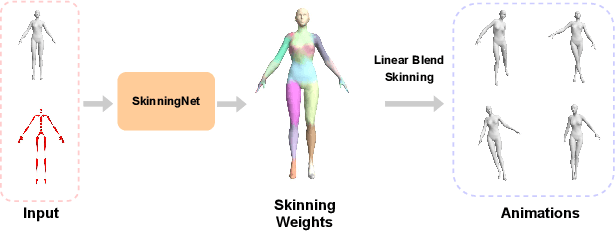
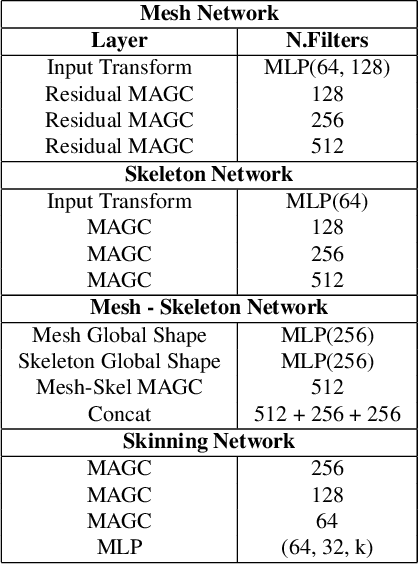


Abstract:This work presents SkinningNet, an end-to-end Two-Stream Graph Neural Network architecture that computes skinning weights from an input mesh and its associated skeleton, without making any assumptions on shape class and structure of the provided mesh. Whereas previous methods pre-compute handcrafted features that relate the mesh and the skeleton or assume a fixed topology of the skeleton, the proposed method extracts this information in an end-to-end learnable fashion by jointly learning the best relationship between mesh vertices and skeleton joints. The proposed method exploits the benefits of the novel Multi-Aggregator Graph Convolution that combines the results of different aggregators during the summarizing step of the Message-Passing scheme, helping the operation to generalize for unseen topologies. Experimental results demonstrate the effectiveness of the contributions of our novel architecture, with SkinningNet outperforming current state-of-the-art alternatives.
Channel redundancy and overlap in convolutional neural networks with channel-wise NNK graphs
Oct 18, 2021


Abstract:Feature spaces in the deep layers of convolutional neural networks (CNNs) are often very high-dimensional and difficult to interpret. However, convolutional layers consist of multiple channels that are activated by different types of inputs, which suggests that more insights may be gained by studying the channels and how they relate to each other. In this paper, we first analyze theoretically channel-wise non-negative kernel (CW-NNK) regression graphs, which allow us to quantify the overlap between channels and, indirectly, the intrinsic dimension of the data representation manifold. We find that redundancy between channels is significant and varies with the layer depth and the level of regularization during training. Additionally, we observe that there is a correlation between channel overlap in the last convolutional layer and generalization performance. Our experimental results demonstrate that these techniques can lead to a better understanding of deep representations.
Channel-Wise Early Stopping without a Validation Set via NNK Polytope Interpolation
Jul 27, 2021



Abstract:State-of-the-art neural network architectures continue to scale in size and deliver impressive generalization results, although this comes at the expense of limited interpretability. In particular, a key challenge is to determine when to stop training the model, as this has a significant impact on generalization. Convolutional neural networks (ConvNets) comprise high-dimensional feature spaces formed by the aggregation of multiple channels, where analyzing intermediate data representations and the model's evolution can be challenging owing to the curse of dimensionality. We present channel-wise DeepNNK (CW-DeepNNK), a novel channel-wise generalization estimate based on non-negative kernel regression (NNK) graphs with which we perform local polytope interpolation on low-dimensional channels. This method leads to instance-based interpretability of both the learned data representations and the relationship between channels. Motivated by our observations, we use CW-DeepNNK to propose a novel early stopping criterion that (i) does not require a validation set, (ii) is based on a task performance metric, and (iii) allows stopping to be reached at different points for each channel. Our experiments demonstrate that our proposed method has advantages as compared to the standard criterion based on validation set performance.
2D-3D Geometric Fusion Network using Multi-Neighbourhood Graph Convolution for RGB-D Indoor Scene Classification
Sep 23, 2020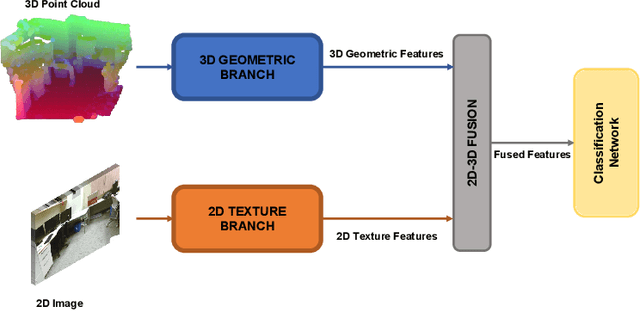


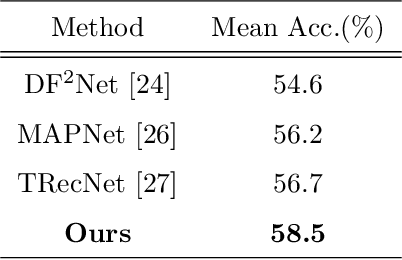
Abstract:Multi-modal fusion has been proved to help enhance the performance of scene classification tasks. This paper presents a 2D-3D fusion stage that combines 3D Geometric features with 2D Texture features obtained by 2D Convolutional Neural Networks. To get a robust 3D Geometric embedding, a network that uses two novel layers is proposed. The first layer, Multi-Neighbourhood Graph Convolution, aims to learn a more robust geometric descriptor of the scene combining two different neighbourhoods: one in the Euclidean space and the other in the Feature space. The second proposed layer, Nearest Voxel Pooling, improves the performance of the well-known Voxel Pooling. Experimental results, using NYU-Depth-v2 and SUN RGB-D datasets, show that the proposed method outperforms the current state-of-the-art in RGB-D indoor scene classification tasks.
FuCiTNet: Improving the generalization of deep learning networks by the fusion of learned class-inherent transformations
May 17, 2020

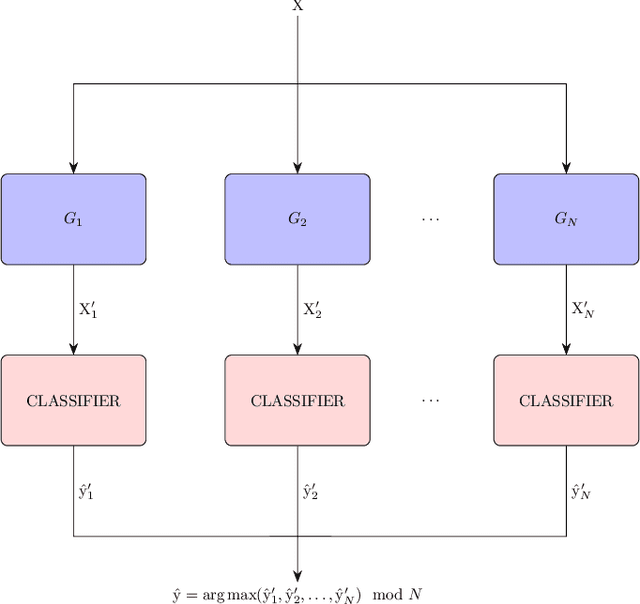
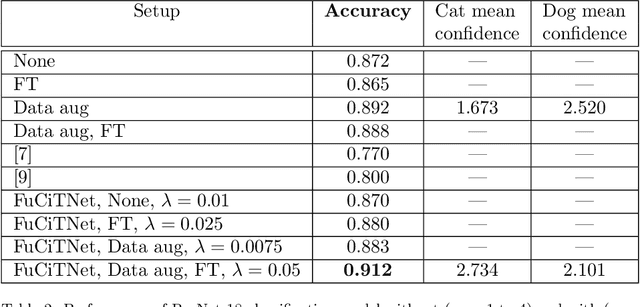
Abstract:It is widely known that very small datasets produce overfitting in Deep Neural Networks (DNNs), i.e., the network becomes highly biased to the data it has been trained on. This issue is often alleviated using transfer learning, regularization techniques and/or data augmentation. This work presents a new approach, independent but complementary to the previous mentioned techniques, for improving the generalization of DNNs on very small datasets in which the involved classes share many visual features. The proposed methodology, called FuCiTNet (Fusion Class inherent Transformations Network), inspired by GANs, creates as many generators as classes in the problem. Each generator, $k$, learns the transformations that bring the input image into the k-class domain. We introduce a classification loss in the generators to drive the leaning of specific k-class transformations. Our experiments demonstrate that the proposed transformations improve the generalization of the classification model in three diverse datasets.
Residual Attention Graph Convolutional Network for Geometric 3D Scene Classification
Sep 30, 2019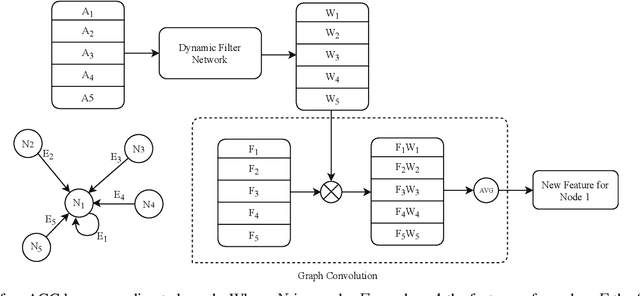


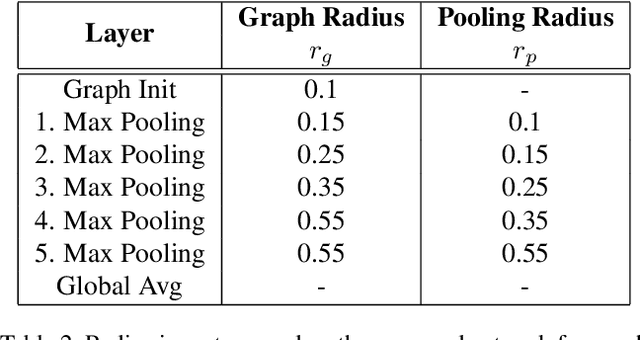
Abstract:Geometric 3D scene classification is a very challenging task. Current methodologies extract the geometric information using only a depth channel provided by an RGB-D sensor. These kinds of methodologies introduce possible errors due to missing local geometric context in the depth channel. This work proposes a novel Residual Attention Graph Convolutional Network that exploits the intrinsic geometric context inside a 3D space without using any kind of point features, allowing the use of organized or unorganized 3D data. Experiments are done in NYU Depth v1 and SUN-RGBD datasets to study the different configurations and to demonstrate the effectiveness of the proposed method. Experimental results show that the proposed method outperforms current state-of-the-art in geometric 3D scene classification tasks.
Hybrid Cosine Based Convolutional Neural Networks
Apr 03, 2019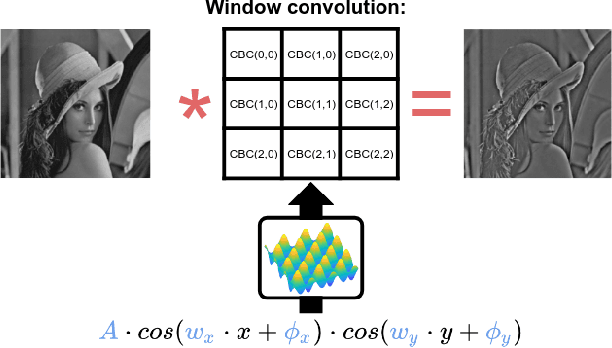



Abstract:Convolutional neural networks (CNNs) have demonstrated their capability to solve different kind of problems in a very huge number of applications. However, CNNs are limited for their computational and storage requirements. These limitations make difficult to implement these kind of neural networks on embedded devices such as mobile phones, smart cameras or advanced driving assistance systems. In this paper, we present a novel layer named Hybrid Cosine Based Convolution that replaces standard convolutional layers using cosine basis to generate filter weights. The proposed layers provide several advantages: faster convergence in training, the receptive field can be increased at no cost and substantially reduce the number of parameters. We evaluate our proposed layers on three competitive classification tasks where our proposed layers can achieve similar (and in some cases better) performances than VGG and ResNet architectures.
 Add to Chrome
Add to Chrome Add to Firefox
Add to Firefox Add to Edge
Add to Edge